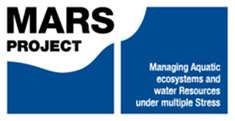Key findings
- 28% of water bodies in the Drava basin are impacted by single, 27% by multiple stressors and only 44% face no or lower human stress.
- The most common stressor combinations involve morphological alteration, connectivity disruption and residual flow alterations; their occurrence varies along the river's course, and their impacts reduce ecosystem integrity.
- The three key stressor types are all associated with hydropower projects and flood protection; so water management should prioritise how the ecological impacts of these activities may be mitigated.
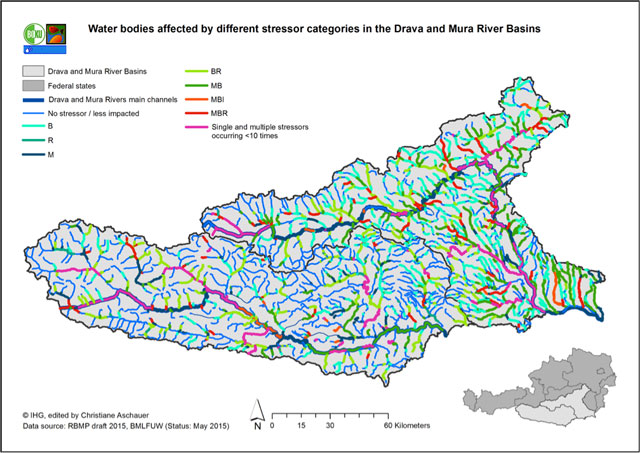
Most frequently occurring stressors in the Drava and Mur
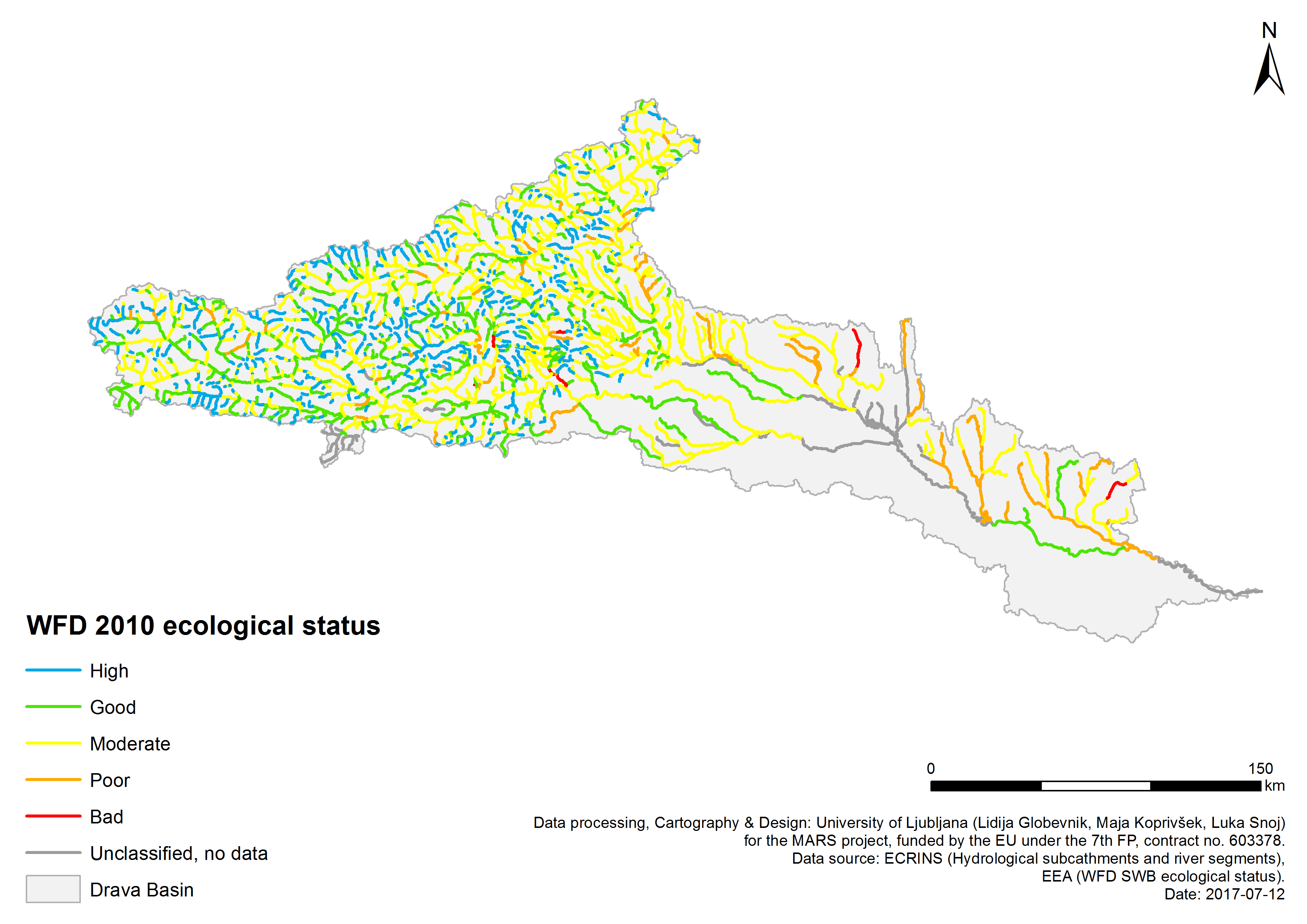
Ecological status of waterbodies in the Drava and Mur basin
Water management issues
In the last River Basin Management Plan assessment, carried out in 2013 and published in 2015, 49.4% of the surface water bodies in the Drava Basin in Austria are below good ecological status. A further 9.9% do not reach good ecological potential, which is the Water Framework Directive objective for heavily modified water bodies. For related water bodies, 21% fail due to residual flow, 8% due to impoundments, 2.8% due to hydropeaking, 32% due to morphological alterations, 46% due to connectivity disruption, 17% due to chemical point stressors and 25% due to chemical diffuse stressors. Water quality issues are not considered to be a management priority in the basin, as most stressors are hydromorphological: many of which are caused by the large number of hydropower plants.
Such hydromorphological stressors are caused by physical alterations of the river channel and bed, particularly through the construction of flood protection, dams and barriers, and the alteration of the riparian area around the river channel. These stressors can alter the hydromorphology of the river (i.e. its shape and flows; particularly through 'hydropeaking', releases of water from hydroelectric plants etc.), reduce connectivity (i.e. the ability of water, nutrients, sediments and organisms to move along the river channel), and impact ecosystem health and status. Such stressors can impact the provision of ecosystem services provided by the river, including fisheries, water purification and recreation and tourism (particularly recreational angling).
Environmental storylines and scenarios
The MARS team studying the Drava basin used computer models to address a range of research questions. First, they wanted to know about the patterns and combinations of stressors in the basin: where did different stressors occur, in what combinations, and in what type of ecosystems? Second, they wanted to find out how these stressors affected fish populations and ecosystem status in different parts of the basin (the so-called 'fish zones' which change along a river's course). Finally, they sought to understand how multiple stressor combinations interacted in the river to impact fish populations and ecosystem status.
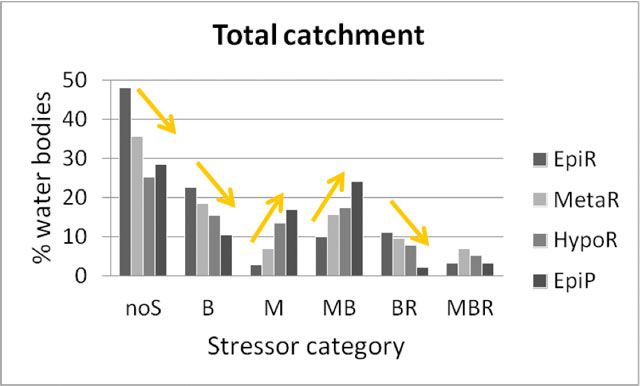
Ecological responses caused by different stressor combinations

Weir in river Mur
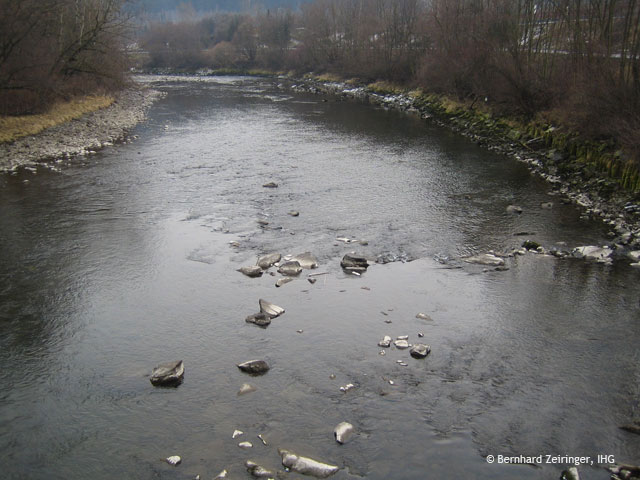
Morphological alterated river banks in the Mur
Results and conclusions
Multi-stressor distribution
The modelling work reveals contrasting ecological responses to stressors in the Drava basin. 28% of water bodies in the basin are impacted by single, 27% by multiple stressors and only 44% face no or lower human stress. Among the water bodies where fish were sampled, only 9% are under low or no stress and 91% are significantly or highly impacted. The most common stressor combinations in the Drava basin are: i) morphological alteration combined with connectivity disruption; ii) connectivity disruption combined with residual flow, and; iii) a combination of all three: morphological alteration, connectivity disruption and residual flow.
Stressor occurrence varied with location along the river course. Broadly, connectivity disruption is the most influential stressor in the upper reaches (as a result of hydropower plants), whilst in the middle reaches, morphological alterations (for example, river straightening) form dominant multiple stressor combinations with connectivity alterations. The proportion of water bodies affected by stressors was lowest in the uppermost reaches sampled (52%), increasing downstream to the highest proportion in the lowermost middle-river reaches (72%).
In the upper reaches of the basin’s rivers (the Epirhithal or ‘upper trout’ zone), connectivity reduction is the dominant stressor (23% of water bodies), occurring both individually and in combinations with residual flow (10%) and morphological alterations (11%). This pattern was repeated in the immediate downstream section of upland rivers (the Metarhithal or ‘lower trout’ zone), where 18% of water bodies were impacted by connectivity reduction.
However, in the next downstream section (the Hypothithral, or ‘grayling zone’) the multiple stressor combination of morphological and connectivity alteration was dominant (17%), with connectivity (15%) and morphological (14%) alterations slightly less prevalent. Where the upland rivers reach lowland landscapes (the Epipotamal, or ‘barbel zone’), 24% of water bodies are affected by the same morphological and connectivity alteration combination, 17% by morphological alteration and 11% by connectivity disruption only.
Multi-stressor impacts
In general, most biotic indicators of fish assemblages in the Drava basin indicate that ecosystem integrity was reduced when single and multiple stressors were present. Morphological alteration was found to be the main stressor shaping the response of biotic indicators in most models.
Fish based indicators and ecological status show contrasting responses to the dominant hydromorphological stressors. This is likely to be caused by a limited methodological approach, based on narrow stressor gradients, aggregated stressor variables and the linkage of one single fishing site to an entire water body.
Significance for water management
All three of the key stressors in the basin – morphological alteration, connectivity disruption and residual flow – are associated with hydropower generation and flood protection construction. Morphological alterations are those, which change the shape and character of the river channel and bed, for example flood walls, instream alterations and barriers. Connectivity disruption is the process by which barriers such as hydropower plants or weirs impede ecological connectivity, for example of migratory fish. Residual flow describes the flow of water downstream of hydropower plants: if too low, habitats may disappear and become vulnerable to pollution and drought; if as variable ‘hydropeaks’ then downstream organisms and habitats may be washed away, and the morphology of the river channel altered.
The identification of these single and multiple stressors can help inform practitioners and other scientists on the most frequently occurring stressor categories and quantities and their distribution and patterns in different parts of the river basin.
The stressor analysis can support river basin managers in identifying water bodies which are degraded by the same stressors to design suitable restoration measures (e.g. restoration of ‘natural’ river channel and flood plain). Future developments in terms of single and multiple stressors can be compared with today’s situation. More broadly, the results demonstrate the value of using multiple indicators for assessing the ecological integrity of rivers and streams.
Basin overview
The Drava River is a tributary of the Danube River, rising in the South Tyrol region of Italy, flowing through Austria and Slovenia (partly forming the border with Hungary) and Croatia, where it meets the Danube near Osijek. The Drava River Basin for MARS analyses covers a total area of around 23,000 km2, also including the Mura River Basin in Austria (a tributary to Drava, also of Alpine character). The Drava Basin is predominantly formed of upland landscapes with significant forest cover, and the dynamics of its water bodies are significantly influenced by snow melt and glacial meltwaters. There are 12 hydropower plants located on the Austrian Drava and 25 on the Austrian Mura, additional, widespread flood protection systems are established.
Context for modelling
The MARS modelling work in the Drava basin used empirical models to identify multiple stressor effects on fish populations using Boosted Regression Trees and Random Forest approaches. The work is framed by the MARS DPSIR conceptual model, which describes how drivers (such as energy production) cause pressures (equivalent to stressors, e.g. dams and barriers), which affect the abiotic and biotic state of the ecosystem, and cause impacts such as ecosystem service loss. As a result, policy and management responses such as restoration may be implemented.
Materials and methods
Fish data was obtained from the ‘Fish Database Austria’ (FDBA), which covers sampling sites throughout the Drava and Mura basins for the period 2006-2014. The fish-based indicators used in the study – metrics such as number of dominant or rare species – were obtained from the Fish Index Austria (FIA).
Facts and Figures: DRAVA
- Key stakeholders:
- Austrian Federal Ministry of Agriculture, Forestry, Environment and Water Management (www.bmlfuw.gv.at)
- Provincial Government of Carinthia – Water Management Section (https://www.ktn.gv.at)
- Contact person: Rafaela Schinegger, BOKU
Further reading
MARS Deliverables:
MARS (2017) Case study Drava - Case Study Synthesis - Deliverable 4.1. (download report, 26.1mb).
Scientific articles and reports:
Humpel M. (2011). Metaanalyse von Eingriffen und deren Restaurationsmaßnahmen an der österreichischen Drau. MSc Thesis, University of Natural Resources and Life Sciences Vienna. (download report, 3mb)
Websites:
Freshwater blog (2014). Meet the MARS team: Rafaela Schinegger (external website)
Project SEE River - Sustainable Integrated Management International River Corridors in SEE Countries - Pilot site Drava in Austria (external website)
